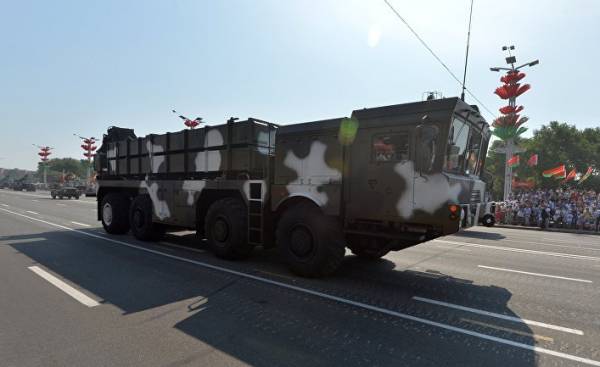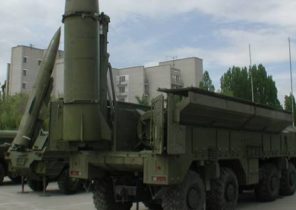
Strengthening of confrontation between Russia and NATO sharply raises the risk of involvement of Belarus in the arms race. “If you want to be feared (and fear for what? In order to not think and did not want again to ride through us, as it was in 1941-1945-m), it is necessary to have a rocket. We got it, and this is only the beginning. We will create even more powerful weapons in order to ensure your safety,” — said Alexander Lukashenko, speaking on 7 July, with the urban village of Kopys.
It is obvious that the President was referring to domestic jet system of volley fire (MLRS) “Polonaise”.
The military presence of NATO on the Federal borders: estimates diverge
Belligerent tirade came shortly after a statement by NATO Secretary General Jens Stoltenberg on the output of the four battalions of NATO in Eastern Europe to the level of full operational readiness.
On 29 June at a press conference on the eve of the meeting of defense Ministers of countries-members of NATO, Stoltenberg said: “In each infantry battalion of about one thousand people. Thus, only about four thousand people. Plus, of course, a national force (the countries of Eastern Europe — approx. ed.) and advanced the US presence in Poland and other States”.
The NATO Secretary General added that “NATO’s military presence is strictly defensive and proportionate in comparison with the tens of thousands of troops that are placed along the borders of Russia”.
With this statement strongly disagree the Russian experts. Referring to open data, they believe that in addition to the multinational NATO battalions numbering from 1.1 thousand to 1.5 thousand people each that advanced in the countries of the region, in Poland is U.S. tank detachment consisting of more than 10 thousand people. A separate training division of Alliance created in Romania.
In the end, according to military analysts, the total number of personnel of the operational readiness of NATO deployed at the borders of Russia and Belarus might exceed 25 thousand people. However, this number does not include the power of the armies of Eastern European States belonging to the North Atlantic Treaty organization.
To ensure that the actions of NATO forces rapidly developing logistics infrastructure, which, if necessary, should ensure the transfer of the region for a short period of time reinforcements numbering from 10 thousand to 100 thousand people. Now they laid in the vault with the weapons and equipment. To control these forces, the region has established six operational-tactical headquarters.
According to many Belarusian and Russian military analysts, infrastructure, modernized according to NATO standards, will allow you to quickly take place and to deploy a multinational military contingents, and, if necessary, to ensure they are offensive.
The military-political leadership of Russia and Belarus regards these actions as a very real threat to be taken seriously and to prepare an adequate response.
Retaliatory rocket fist
Apparently, one embodiment of such a response is the creation of the Belarusian army powerful rocket fist for the destruction of the border military infrastructure and the suppression of offensive groups of the potential enemy.
Today, every combat vehicle MLRS “Polonaise”, based on the four-axle all-wheel drive chassis MZKT-7930, can simultaneously apply a spot-kick on eight targets at ranges of up to 200 km At this distance the deviation from the target missile is 1.7 m. When capacity ammunition 50 kg in a trotyl equivalent it — “guaranteed defeat”.
According to experts, to achieve such results, the control unit missile has to be at least equipped with inertial guidance system, an augmented navigation system based on GLONASS/GPS.)
The division of the nine “Polonaises” may to perform two missile salvo of 72 rockets each, hitting the target enemy on a plot size of 10 x 10 km.
Each of the combat vehicles division can be equipped with missiles with different types of warheads, including high explosive, cluster with tens to hundreds of submunitions, as well as special tape with several (4-8) homing cumulative elements to defeat enemy armored vehicles.
November 3, 2015 when you visit the precision electromechanics plant in the Dzerzhinsk district of the Minsk region Alexander Lukashenko was informed that in Belarus there is a center consisting of scientific and production departments working on creating advanced missile systems. Tasked to localize their production to 95%.
Then the head of goskomvoenproma reported to the President that national experts in the near future (2016-2017) will be released to establish their own rockets to “Polonaise” with a range much greater than 200 km (and according to some sources up to 300 km).
According to military analysts, for a hypothetical European theater of operations, the effectiveness of these missiles can not be worse than the Russian operational-tactical missile complexes (PTRC) “Iskander”.
Moreover, according to some experts, the effect of a massive volley of guided rockets MLRS “Polonaise” can be several times higher than the result of the impact point of “Iskander”. At ranges of over 200 km, they will virtually be wiped off the face of the earth the whole military division of the potential enemy.
The American Patriot as a response to the Russian “Iskander”
In this context it should be taken into account and possibilities of the rapidly developing us missile defense system and modern air defense/missile defense, which is going to buy some Eastern European countries-members of NATO.
Recently, the United States and Poland signed the Memorandum of sale Washington Warsaw advanced missile defense systems Patriot PAC-3, which is positioned as a response to the deployment by Russia from the Polish border, the PTRC “Iskander”.
Only Warsaw is planning to purchase eight Patriot. The first of them should be delivered to Poland by 2022, and the achievement of full operational capability is expected by 2023-mu.
In the comments of the experts on this transaction indicated that Poland wants to buy the Patriot in the configuration c an integrated battle command system (Integrated Battle Command System IBCS) manufactured by Northrop Grumman. It is created for advanced system Integrated Air and Missile Defense (IAMD) of the U.S. army. The latter is created to replace the Patriot air defense system.
It is also expected that following Poland new anti-aircraft missile systems such as Patriot PAC-3, SAMP-T and MEADS — will be transferred to the armies of the Baltic States. The maneuvering capabilities which have been used interceptors ERINT and Aster-30 are large enough. In the future, with the development of guidance systems, they can pose a threat even for the PTRC “Iskander”.
For example, in the Patriot air defense system very soon all the radar with a passive phased array (PAR) AN/MPQ-53 will be gradually replaced with more high-potential radars with active phased array, which allows to detect and track dozens of targets with an effective reflecting surface less than 0.02 m2.
However, according to Russian military analysts, the use of the Patriot system PAC-3 MSE is unlikely to be able reliably to defend Poland in case of application against her ammunition missile complex “Iskander”. Not afford it and a more modern missile interceptors Standard SM-3.
One of the main features of “Iskander” is the use of a large set of diverse tools to overcome missile defense, making it comparable in terms of invulnerability to strategic missile complexes “Topol-M” and “YARS”. However, the possibility of Western missile defense systems year-on-year increase.
At the same time, now 72 simultaneous volley of missiles is the only division of the Belarusian MLRS “Polonaise” doing the impossible task of their complete interception of modern means of missile defense. But if under this “guise” a couple of times and shoot “Iskander”…
Hypothetical goal of “Polonaises”
Quite an expected reaction of the Belarusian military and political leadership on the emergence of the Western neighbors of the Patriot systems may be increasing in the armed forces of Belarus as the number of jet systems “Polonaise” and the distance of their shooting. What, in fact, Lukashenka said, communicating with fellow residents from Kopys.
According to some commentators, in a hypothetical confrontation between Belarus and Russia with NATO goals for “Polonaises” can become air base Minsk Mazowiecki, Deblin (Poland), Zokniai (Lithuania) and Rezekne and lielvārde (Latvia).
Advanced command centers of the compounds of NATO’s rapid reaction, polygons, Nowa dęba, Elk (Poland), Rukla and pabradė (Lithuania), which can accommodate units of the Alliance are also in range of the Belarusian MLRS.
Thus, the strengthening of confrontation between Russia and NATO sharply raises the risk of involvement of Belarus in the arms race. That’s just not whether it would be fatal for the weak Belarusian economy?







